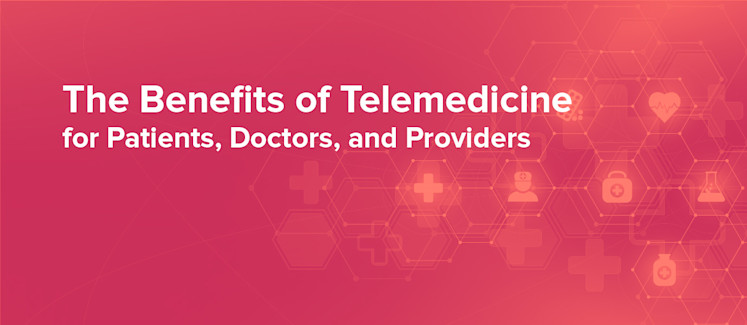How Telemedicine Benefits Patients, Doctors, and Providers

The adoption of communications technology in the healthcare industry has led to a growing world of innovative approaches to telemedicine. These applications enable the remote communication of medical information, advice, and treatment. Implementations can range widely: remote patient monitoring technologies might allow patients with diabetes to monitor their blood glucose through mobile apps. Or, they might facilitate virtual doctor consultations through video conferencing, voice calls, and synchronous 1:1 chat.
Telemedicine has been growing over the last decade. As one indicator, the American Medical Association found that telemedicine-based insurance claims grew 53% in recent years. Despite this growth, telemedicine remains a small share of overall care-- less than 1%-- and has been slow to gain traction in the United States.
Yet, the demands for medical advice and the restrictions on movement during the outbreak of COVID-19 have renewed the need for, and interest in, applications that enable healthcare at home.
Across implementations of different types, telemedicine applications offer recurring benefits, expanding access to quality care while presenting opportunities for healthcare providers to improve operational efficiency.
What follows are just a few of the benefits of telemedicine uncovered in its use so far, indicating that this technology holds promise for both healthcare providers and the health technology companies that will invest the time and resources to develop it.
Reach patients who would otherwise be left waiting
Often, doctor’s appointments are either booked in advance, or are routine check-ups set at regular intervals. But, this can create an uncomfortable limbo for those with non-emergency symptoms, chronic problems, or ongoing mental health challenges.
Rather than leave patients caught in a binary between seeing a doctor and being on their own, telemedicine allows access to medical advice, even while on the waiting list.
Indeed, when used as a supplement to office visits, chat-based consultations can serve as effective treatment, especially when it comes to mental health. Even while waiting in the system, patients can access advice, care, and treatment using telemedicine. In turn, this allows patients to practice preventative care, and helps lower treatment costs overall.
Reduce operational costs without sacrificing quality
On that note, one of the major benefits of telemedicine is that it gives healthcare providers multiple opportunities to reduce costs. By nature, they take a load off of brick-and-mortar clinics, and can offload traffic from nurse call-lines. Consultations taken via chat apps actually improve patient engagement and satisfaction, letting healthcare providers lower operational costs without negatively impacting patient outcomes.
The core tenet here is efficiency. Using doctor-patient chat, healthcare providers can refer patients to relevant departments before they walk in the door. Similarly, prescriptions can be filled, and some symptoms can be checked or monitored remotely. When compared to traditional call-lines, patient-nurse chat apps can result in half as many in-person visits, lower expenses, and higher patient satisfaction. With responsive chat, healthcare providers can expand service while saving on costs.
Ensure better patient outcomes
Of course, all the savings in the world would be worthless if telemedicine negatively impacted patients. Luckily, the opposite tends to be true. In addition to augmenting check-ups and consultations, telemedicine apps can play an important role in long-term, at-home care regimens.
With app-assisted treatment, patients can access knowledge, monitor their own symptoms in conjunction with their doctor, and contact healthcare professionals when questions arise. In other words: no more WebMD.
Some telemedicine apps actively check in with patients, and this leads to care that sticks. As augmentations to established medical methods, these approaches allow doctors to serve as coaches and supervisors, teaching patients to take an active, ongoing role in their own treatment.
Together, this results in better patient experiences and health outcomes, with the added benefit that educated patients are more capable of preventative care, and therefore stand to draw on fewer healthcare resources in the future.
Overcome barriers to care
As has become apparent this year with the restrictions born of COVID-19, physical barriers have driven the rapid growth of telemedicine. But, even when movement at large is unrestricted, mundane things can be substantial barriers to care.
Even setting aside cost, smaller things can get in the way. Finding time during the work week to make an appointment, distance from facilities, or a simple lack of transportation prevents many Americans from accessing care. For rural patients, clinics and hospitals may simply be out of reach for routine check-ups, or for regimens that require more frequent attention.
To clinics, no-shows waste resources, time to coordinate office staff, and time slots that could have been allocated to other patients instead.
By its very nature, telemedicine offers a way to overcome these barriers to care. Text chat, voice, and video lets doctors and nurses reach patients where they are. As vehicles for higher-touch interactions between medical offices and patients, these apps also make it easy for patients to notify staff of scheduling issues. Then, it's easy to set new appointments or move to a remote check-in. This benefit may seem like an intuitive feature of doctor-patient chat apps, but it is well-worth calling out.
Takeaway
Whether by nature of virtual communication itself, or in the details of a specific implementation, the potential benefits of telemedicine apps are many and varied.
At their root, apps that enable in-app chat between doctors and patients allow healthcare providers to overcome physical barriers to care. Beyond this, they let doctors reach patients who need treatment, but who would otherwise simply be waiting for their appointments.
Following treatment, this technology enables continuity of care by giving doctors a simple way to actively check in with, and empower, patients on long-term regimens. Finally, for healthcare facilities, the benefits of rich, virtual communication mean offloading traffic from physical locations and phone lines, reducing costs while improving patient satisfaction.
Overall, telemedicine is a promising field for patient-doctor communications, and its benefits have only just begun to reveal themselves.


